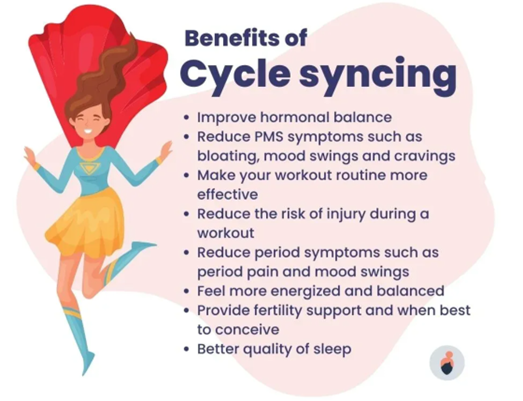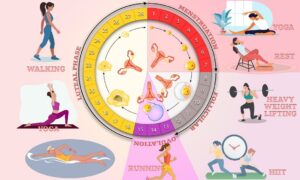Cycling syncing is the practice of adapting aspects of health and lifestyle habits to compliment the four phases of your menstrual cycle. There are many different lifestyle changes which can assist with cycle syncing including diet, sleep, and physical activity, however, research has identified just adapting physical activity can positively impact mood, energy, and menstrual symptoms.
What are the phases of your menstrual cycle?
| Phase | Days (approx.) | Interaction of Hormones |
| Menstrual (part of follicular phase) | 1-5 | Estrogen and progesterone are low. The lining of the uterus (endometrium) is shed causing bleeding. |
| Follicular | 6-14 | Estrogen and progesterone are on the rise. |
| Ovulatory | 15-17 | Estrogen peaks, testosterone, and progesterone rise. |
| Luteal | 18-28 | Estrogen and progesterone levels are high. |
Throughout your menstrual cycle, there is a natural rise and fall of energy levels based on the levels of sex hormones estrogen, progesterone, and testosterone. Matching exercise to your cycle is as simple as completing low to moderate intensity physical activity on days when you have lower energy and completing moderate to high intensity physical activity on days when you have higher energy.
What does this look like?
Exercise during the menstrual phase
Your energy levels are the lowest during this phase, this time can be spent doing low-intensity activities such as walking, stretching, yoga or Pilates. You may not feel like exercising at all, and that is completely okay.
Exercise during the follicular phase
As energy levels start to increase, start adding in cardio based workouts to get your heart rate pumping. These can include jogging, swimming, hiking, group fitness classes and boxing.
Exercise during the ovulation phase
Take advantage of your peak energy levels with high-intensity workouts such as kickboxing, cycling, boxing, running and boot camp.
Exercise during the luteal phase
Energy levels will start to decline as menstruation approaches, take this time for moderate to low intensity cardio and strength training including yoga and Pilates.
Note that these are general guidelines for exercise based on predicted energy levels during each phase of your cycle. It’s important to listen to your body and adapt your workouts to fit your needs.
Who can benefit from cycle syncing?
While everyone can benefit from cycle syncing, there are certain groups who may benefit the most. This includes women who have PCOS, endometriosis, are overweight, have difficulty with energy levels or are planning to conceive.

If you are wanting to learn more about how other lifestyle choices can impact your menstrual cycle, it’s best to contact a Dietician for nutrition advice and an Exercise Physiologist for physical activity.




